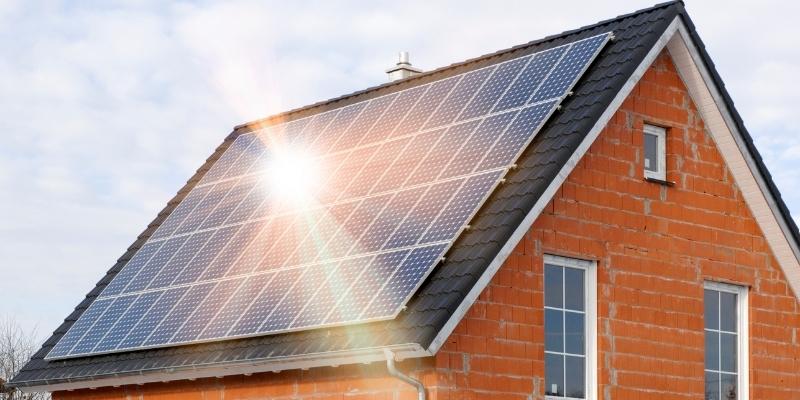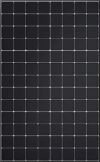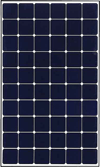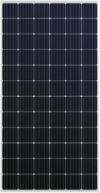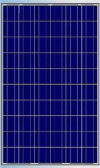Photovoltaic solar panels
In the UK, photovoltaic (PV) systems are frequently utilised solar panel systems. Solar energy is directly converted into electricity by photovoltaic systems.
Semiconductors, like silicon, are used in solar cells to capture solar energy and transform it into electrical energy.
A solar panel is a frame that contains a collection of electrically linked solar cells. A solar array is created when several solar panels are connected to one another. Finally, the entire system comes together to form your solar panel system once you’ve included the cabling, brackets, inverter, and other components.
An electrical circuit is created by connecting the electrical conductors to the positive and negative terminals. From there, an electric current can be used to collect the electrons (electricity). This current determines the power (or wattage) that the solar cell can produce and is how solar panels convert sunlight into electricity. The voltage of the cell is a product of its internal electric field or fields.
PV Systems: Grid-Connected vs. Stand-Alone
Grid-connected systems utilise the regional utility grid to guarantee that you never go without power. If your home solar power system produces more electricity each day than what your household needs, the extra energy can be exported back to the main power grid. But if you require more electricity than your solar panels have produced, the grid can provide it.
Independent PV systems charge a solar battery system instead of being linked to the grid. The electricity produced by your solar panels is stored in these batteries. These batteries’ stored energy will be used to power your gadgets. Because solar batteries are still fairly expensive, stand-alone systems are utilised in places that cannot be connected to a grid and are often more expensive than grid-connected systems.
Batteries for solar energy
When your solar panels are not producing electricity in the nights, solar batteries allow you to utilise the electricity they have stored. Whether you are plugged into the grid or not, you can use solar batteries.
Depending on the size and capacity, solar battery storage systems can cost anywhere from £1,200 and £6,000. But every year, new solutions are being created thanks to technology, which suggests that solar battery costs will eventually go down.
Collectors for solar heat
Solar thermal panels heat water that is kept in a cylinder using sunshine, and you may utilise the heated water to heat your house. Similar to solar PV panels, solar thermal panels are put on roofs but have a significantly different appearance because they feature several pipes heating water rather than solar cells. Thermodynamic panels, which draw heat from the surrounding air, are a related technique.
Although solar thermal and thermodynamic panels can both be used for space heating, they are most frequently employed to meet a household’s domestic hot water (DHW) needs.
In the UK, how effective are solar panels?
In the UK, solar panels are quite effective. Solar panels do not require direct sunshine in order to function, though bright days increase their efficiency. On overcast days and in the winter, solar panels can still provide a sizable amount of electricity.
In actuality, lower temperatures are better for solar panels. In nations with extremely warm climates, solar panels might overheat. As a result, the majority of the year in the UK is optimal for the product’s effectiveness.
 Snowy Climates Can Still Use Solar Panels
Snowy Climates Can Still Use Solar Panels
Solar panels are incredibly efficient even in cold climates thanks to a phenomena called the “albedo effect.” Similar to how skiers and snowboarders can easily become sunburned on the slopes, more electricity can be generated because of the way snow’s white colour reflects sunlight. Naturally, the solar panels must first be cleared of snow for the system to function. Anything covering your solar panels will lower their efficiency.
The efficiency rate of a typical commercial solar module is between 15 and 20 percent. Increasing module efficiency while maintaining a low cost per cell is one of the PV industry’s key challenges.
Naturally, a variety of factors, including as the type of solar panel you choose, angling, and seasonality, can impact how effective your system is.
The idea that solar panels perform poorly in the winter is a widely held one. Solar panels can, however, still be useful throughout the winter if they are properly installed and maintained.
The graph below displays the year average energy output from a south-facing 4kW household solar panel system installed on a roof with a 40-degree pitch. In the winter, solar panels can supply 33-51% of the energy needed to run a home.
Kilowatt-hours are the unit of measurement for solar panel output (kWh). Add the minimum and average amounts to get the average energy output. Add the three together to get the maximum output.
A 4kW Solar Panel System’s Monthly Energy Production in the UK
Because the amount of sunshine varies by area in the UK, we have divided the average monthly energy output by major cities into distinct regions to help you understand the potential energy output.
Solar panel efficiency is impacted by four main factors.
To get the most out of your solar investment and to reduce your electricity bill expenses, you’ll want to maximise the efficiency of your solar panels. Location, angling, direction, roof compatibility, solar panel system size, and proper maintenance are important considerations. Let’s examine each one individually.
1. Place, Angle and Direction
Is the PV system positioned and slanted to allow solar cells to absorb the most sunlight possible? You should make sure that your solar panels in the UK receive direct sunshine from 9 am to 3 pm.
A critical step in determining the effectiveness of the system is evaluating your roof’s potential to support solar panels. How much sunshine your panels will receive depends largely on the orientation and pitch of your roof.
South is the best orientation for solar panels because it ensures that they receive the most sunshine exposure. The optimal location for solar panels in the UK is at a 34° roof tilt angle, according to Stanford University.
You can place brackets to gently change the angle if your roof isn’t oriented or angled in the best way. However, have a licenced MCS installer evaluate this.
| Roof Angle |
Orientation |
| North West135° |
West 90° |
South West 45° |
South 0° |
South East 45° |
East 90° |
North East 135° |
| 0° |
83.5% |
83.5% |
83.5% |
83.5% |
83.5% |
83.5% |
83.5% |
| 15° |
73.6% |
83.5% |
90.2% |
93.7% |
90.8% |
83.0% |
74.3% |
| 30° |
64.0% |
79.4% |
93.3% |
99.3% |
94.5% |
81.2% |
65.4% |
| 34° |
61.7% |
78.4% |
93.5% |
100.0% |
94.8% |
80.4% |
63.1% |
| 45° |
55.6% |
75.1% |
92.5% |
99.9% |
94.1% |
77.3% |
56.9% |
| 60° |
47.4% |
68.7% |
87.5% |
95.7% |
89.4% |
70.7% |
48.3% |
| 90° |
30.3% |
49.6% |
66.1% |
72.6% |
67.8% |
50.5% |
30.7% |
 Instead of utilising standard inverters, which are preferable for large-scale solar farms, a homeowner can get the most electricity out of their array if their home is not ideal (for example, it has an odd roof angle or partial tree shade). Given that it prevents losses from partial shadowing, the majority of solar installers will present one or both of these options. To determine how important trees are in your home, you can also use Google Sketchup.
Instead of utilising standard inverters, which are preferable for large-scale solar farms, a homeowner can get the most electricity out of their array if their home is not ideal (for example, it has an odd roof angle or partial tree shade). Given that it prevents losses from partial shadowing, the majority of solar installers will present one or both of these options. To determine how important trees are in your home, you can also use Google Sketchup.
 Joshua M. Pearce, A specialist in solar photovoltaics
Joshua M. Pearce, A specialist in solar photovoltaics
The John M. Thompson Chair in Information Technology and Innovation is held by Joshua M. Pearce. He is employed with Western University’s Electrical & Computer Engineering Department and Ivey Business School. He is the leader of the research team for Free Appropriate Sustainability Technology.
2. Fit for a Roof
It’s crucial to evaluate if your roof is sturdy enough to sustain the weight of the solar system when thinking about installing solar panels on it. For instance, a 4kW system typically consists of 16 250W panels, weighing a combined total of about 280kg.
Today, almost any material can support solar panels; slate and hardwood roofs can be too brittle.
Additionally, think about if your roof is big enough to support solar panels. When determining how much roof space is available, remember that you will need at least 30 cm of clearance around your solar panels. For instance, at least 29 m2 of roof area is needed for a 4kW system with 16 panels.
3. System Size of the Solar Panels
Solar cells are available in a wide range of sizes and forms. The amount of electricity produced increases with the size of the solar panel installation. You’ll have a better notion of the size panel you require once you’ve determined your electrical requirements.
Since monocrystalline panels are the most effective solar panel type now available, you will need fewer of them (and consequently less roof area) to produce the same amount of electricity as a polycrystalline system.
4. Maintenance
To extend the life of your system, it’s critical to do the proper solar panel maintenance. Fortunately, solar panels don’t need a lot of maintenance over the course of their 25-30 year lifespan.
Have your installer or another qualified service provider inspect your panels on a regular basis. If you attempt to do this on your own and damage your panels in the process, your warranty may be voided.
You can take care of keeping your panels clean by yourself. In order to accomplish this, take off the leaves and branches from your solar panel system and rinse them with a garden hose, being careful not to touch or sponge them.
What Number of Solar Panels Are Required?
Approximately 16 solar panels with a 250W power output are needed for a 4kW solar panel system, whereas 20 panels are needed for a 5kW system.
Several factors determine how many solar panels you need to power your home, including:
- Your present electricity usage
- Aims for your energy (how much of the consumption you plan to cover)
- the size of your roof
- the duration of daylight in your area
It is crucial to evaluate each household separately because these criteria vary from home to home.
Identifying your existing energy consumption is the first step. It’s crucial to take the time necessary to calculate this as precisely as possible because you measure this in kilowatt-hours (kWh).
 How to Determine Your Solar Energy Needs
How to Determine Your Solar Energy Needs
- To determine your power use, check your electricity invoices (in kWh). You can either aggregate your monthly and quarterly usage together to get an annual figure or calculate month by month.
- Choose the percentage of your electricity costs that you want your solar panels to offset, which might range from 10 to 100. The size and cost of the system will be impacted by your choice.
- Determine the number of solar panels that will fit on your roof. 1.44 m2 of roof area is required for a typical solar panel. Remember to include at least 30 centimetres from the edge of the roof. If you find that you don’t have enough room for all the panels you projected, reduce the system size.
Based on System Size, Solar Panel Price
A typical household solar panel system will cost between £5,000 and £10,000. How many solar panels you need for your home will determine the final cost, which in turn will depend on your energy usage.
In general, a more expensive system will be able to produce more electricity and, as a result, more savings. The table below illustrates your annual electricity bill savings per system size, the amount of Smart Export Guarantee (SEG) payments you can receive, and eventually how long it might take to break even.
Average UK savings and costs for solar panels
| Household Size |
System Size |
System Cost |
Annual Savings on Electricity Bill |
SEG Payment |
Break-Even Point |
| Small |
3kW |
£5,000‑£6,000 |
£160 |
£75 |
21-25 years |
| Average |
4kW |
£6,000‑£8,000 |
£270 |
£100 |
16-22 years |
| Large |
6kW |
£8,000‑£10,000 |
£430 |
£150 |
19-23 years |
A 3kW solar panel system, which costs £5,000- £6,000, may adequately cover the electrical bills of a modest house with 1-3 occupants. With that system, the free energy generated by your solar panels allows you to save £160 annually on your electricity bill. Additionally, you can even make £75 a year with SEG payments.
A 4kW system, which costs between £6,000 and £8,000, is often installed in a home with a family of 3-4 people. In this case, you may save around £270 on your annual electricity bill and even make an additional £100.
A 6kW solar panel system would be necessary for larger residences that can accommodate 4+ persons. This can range from £8,000 and higher. With a 6kW system, you can cut your annual power costs by a stunning £430 while also earning an extra £151 in SEG payments.
You are not, however, constrained to these three options alone. The number of panels and the wattage of each panel determine the system size, so you can tailor the system size to your needs, for example, by having a 3.5kW solar panel.
The cost will be significantly more if you are installing solar panels for a business because the sizes would be very different.
 Systems with the most solar panels
Systems with the most solar panels
-
- solar panel systems of 1 kW
- solar power systems with 2 kW
- 3 kW solar panel installations
- solar panel systems 4 kW
- solar panel systems 5 kW
- solar panel systems 6 kW
- solar panel systems 12 kW
Is Purchasing Solar Panels Worthwhile?
In addition to the obvious environmental advantages, SEG profits allow you to install solar panels much more quickly and break even. Solar panels are also becoming more and more accessible thanks to ongoing technological advancements.
You can recover your investment in solar panels within the life of the system, taking into account the cost, savings, and earnings described before.
For instance, after 21-25 years with a 3kW system, you can break even. After 16 to 22 years, a 4 kW system will pay for itself. Finally, you can reach break-even point with the larger 6kW system after 19-23 years.
So, if you’ve ever wondered whether investing in solar panels is worthwhile, the answer is yes.
Are Your Electricity Bills Lower With Solar Panels?
Your electricity bill can be decreased using solar panels. Where you live will determine how much you can save on costs. For instance, you can reduce your annual electricity costs by an average of £100-£270 in London. You can cut your annual bills by £90 to £230 in places like Stirling or Manchester.
Do Solar Panels Raise Your Home’s Value?
As your home becomes more energy-efficient thanks to solar panels, its value may rise. As the future owners will also benefit from lower electricity costs, this is one of the home upgrades that will increase your house’s appeal to potential buyers.
It goes without saying that the size of the solar panel system will have an impact on how much the value will rise. You should also keep in mind that different families will have varied energy consumption patterns. Thus, a single approach can be suitable for some families while failing others.
It depends on personal opinion because for some consumers, solar panels are not a worthwhile addition to a house.
Does Purchasing Cheap Solar Panels Make Sense?
Solar panels can be pricey, therefore some people will search for the least expensive option. Cheap solar panels can save setup costs, but they might not be cost-effective in the long run. After all, making a decision to invest in solar energy has long-term repercussions. Your savings might not be as large because cheap solar panels are likely to last less time and perform less efficiently.
Solar panel costs should not be the sole consideration when deciding whether to install solar panels on your home. Long-term savings can be realised by purchasing superior panels and, in particular, an inverter from an MCS-certified installation with a solid local reputation.
Are solar panels available for no cost?
Free solar panels are no longer available in the UK. In the past, at the height of the Feed-in Tariff, solar panel suppliers launched the free solar panels programme (FIT).
In order to enable homeowners to use the electricity generated to power their homes, solar panel companies would offer to install solar panels for free. It would be a beneficial arrangement for the company because these providers would obtain the FIT payments in exchange.
This arrangement grew less profitable for suppliers commercially as FIT payment levels declined over time. Free solar panels were no longer accessible once the FIT was completely discontinued in 2019.
Are Solar Panel Grants Available in the UK?
Through a variety of solar panel funding options, you can profit from your solar panels in the UK. The Smart Export Guarantee and the Feed-in Tariff are both in effect at the moment (which is closed for new registrations).
The Feed-in Tariff (FIT), a government payment programme for solar panels, promoted the adoption of renewable energy sources in the UK, including solar PV. It was implemented in 2010 and provided homeowners that produced and exported renewable energy with a tariff (a payment).
The government ended this programme in 2019. No new applications are accepted, although those who are still registered under the FIT continue to receive payments in accordance with their agreements.
The Smart Export Guarantee (SEG) has taken the place of the FIT as of January 1st, 2020. The SEG allows UK homeowners to make money by returning excess energy to the grid.
According to the SEG, all energy providers with more than 150,000 clients are required to provide a tariff for electricity sold to the grid. The tariff can be set up however the individual energy suppliers see fit, but it must be higher than zero. A reasonable export rate is 4-6p/kWh.
What options are available for financing solar panels?
The new VAT decrease on energy-saving products is another alternative for financing solar panels. You qualify for a discount on your solar panels if you are over 60 or receiving income- or disability assistance. The government’s website lists particular eligibility requirements, which you can read.
Funding choices and governmental initiatives are typically revealed or alter from month to month. Don’t forget to subscribe to our newsletter so we can keep you informed of any relevant changes in the future.
Solar Panels in the UK: Pros and Cons
Solar panels provide a lot of benefits, and they significantly contribute to the development of sustainability. There are presently more than 1 million solar PV installations, and in 2018, the UK generated 3.9 percent of its total electricity using solar energy. Over time, the UK’s solar power capacity will only rise.
Solar cells not only reduce your electricity bill significantly but are also environmentally friendly. Solar panels have drawbacks, but overall, investing in solar technology has many more advantages than problems.
Over time, there has been a little increase in sunshine hours, which means your solar panel investment will continue to pay off. The graph below depicts how the UK’s sunshine hours have been rising over time.
Chart from 2010 to 2019 depicting the typical daily sunshine hours in the UK
Solar panels have several drawbacks that must also be taken into account if you want to utilise them as a free source of electricity for your home. The primary benefits and drawbacks of this renewable energy source are listed below.



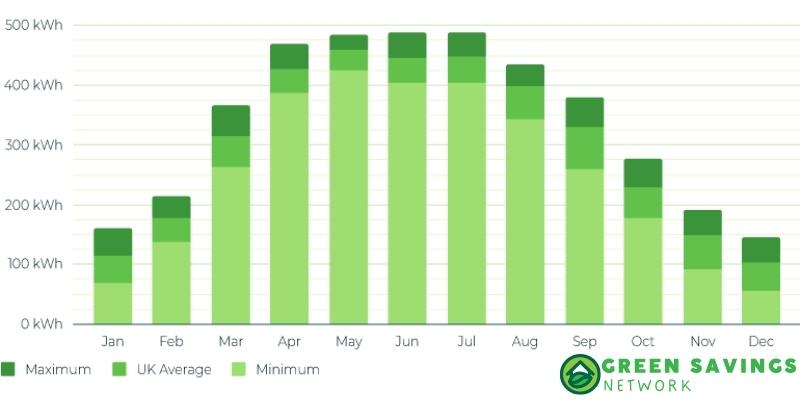
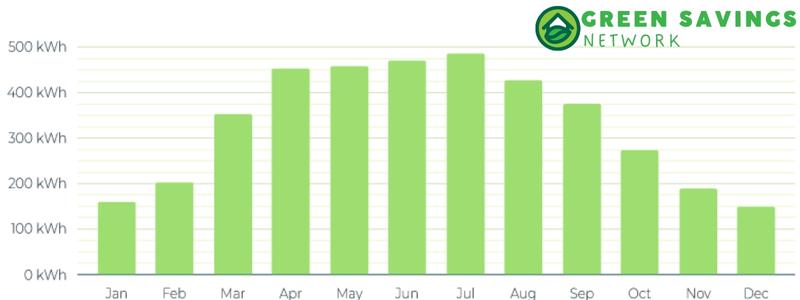



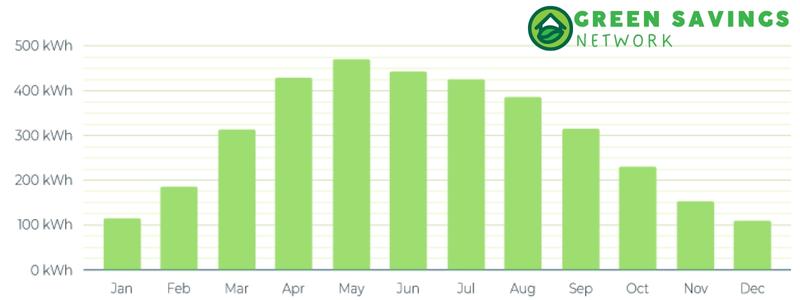
 Joshua M. Pearce,
Joshua M. Pearce, 

